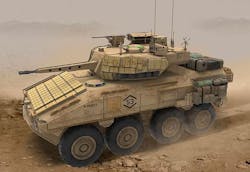SAIC to build Marine Corps Armed Reconnaissance Vehicle (ARV) with state-of-the-art advanced vetronics
Officials of the U.S. Office of Naval Research in Arlington, Va., announced a $19 million contract to SAIC on Thursday for a portion of the Armed Reconnaissance Vehicle (ARV) program that involves advanced high-risk technology development called "at the edge."
The future ARV will be able to fight for information on a complex and contested battlefield using an automatic rapid-fire medium-caliber cannon, remotely operated medium-caliber machine gun, and open-architecture advanced vetronics to include sensors, communications, and battlefield networking.
The project seeks to build two ARV variants -- a base model and an at-the-edge model -- to evaluate technologies, performance, and battlefield concepts. Contractors will build two demonstrators of each variant. SAIC has been selected for the at-the-edge model. Other contractors will handle the base variant.
SAIC engineers will develop an at-the-edge ARV demonstrator with relatively high-risk technologies -- some of which could have limited operability with development paths that would lead to full capability. This demonstrator is to push the upper limits of capability and performance.
The at-the-edge variant that SAIC will build will be operational, but isn't supposed to have the durability necessary to withstand sustained operations on the battlefield. It is to demonstrate enabling technologies at technology readiness level 5, which seeks to validate components in a simulated or real environment.
Related: Solicitation released for new Marine Corps armored vehicle with open-architecture vetronics
SAIC's at-the-edge demonstrator will push the limits of combat vehicle enabling electronic technologies such as a self healing cyber-safe electrical and data distribution architecture; and power generation for all on-board systems with a 25 percent power buffer, with support for 100 percent power growth within 10 years for power and distribution, data distribution and processing, and memory storage.
Other electronics that SAIC engineers will address in this project are communications with technology refresh updates every four years that supports secure voice, video, and data exchanges in GPS-denied environments; interfaces to launch, control, retrieve, and recharge unmanned aerial vehicles (UAVs) and unmanned ground vehicles (UGVs); modular electronic architectures to support insertion of emerging technologies and multi-mission payloads; and manned and unmanned teaming operations with robotics and autonomy.
The SAIC ARV demonstrator also will have protection from direct fire, underbody, and top attacks; energy-attenuation seats to protect the crew from IED attacks; water mobility sufficient for shore-to-shore operations; transportability aboard a landing craft air cushion (LCAC); and crew vision systems for reconnaissance.
The ARV demonstrators will be designed to collect mobility data, determine reconnaissance and sensing capabilities, determine unmanned systems integration and operation, evaluate platform lethality, determine platform survivability, and evaluate overall performance.
Technology demonstrators will have modular open systems architectures, with an eye to future integration of third-party hardware and software and will enable third-party repair.
The base variant and its vetronics will have an average manufacturing unit cost of $6 million per platform for 500 units, with initial operating capability (IOC) in 2027. The SAIC at-the-edge version, with its advanced high-risk technologies, has no IOC date.
The vehicle will have new ways to sense and communicate, will be able to destroy heavily armored threats close-in and at range, and will be transportable with the naval expeditionary force by military and commercial trailers, railway, C-17 fixed-wing aircraft, naval amphibious warfare ships and surface connectors, and military sealift command and commercial ships.
The ARV will have persistent surveillance capability using manned and unmanned vehicles; modern command, control, communications, and computers (C4I) vetronics; cross-country and on-road land mobility with shore-to-shore water mobility; passive and active force protection; direct and indirect weapons; be similar size and weight to the legacy LAV; drive-by-wire capability; and a modular interoperable open-systems architecture.
The new reconnaissance vehicle will identify weapons and targets through obscurants, beyond threat range, and beyond line of sight. It also will be able to transmit sensing and targeting information among the crew, the dismounted scout team, other ARV crews, and other Marine Corps sensors, as well as collect, process, and exploit sensor information and disseminate it to other Marine Corps units.
It also will be able to communicate voice, video, and data where sensors and communications are degraded. Its command and control system will handle weapons fire control; secure voice, video, and data exchanges; battlefield situational awareness in GPS-denied environments; and control unmanned systems beyond line of sight. Its communications network suite also will be able to operate through cyber attacks, and the vehicle will minimize its visual, infrared, RF emissions, radar cross section, and acoustic signatures.
The ARV will be survivable against weapons as large as heavy machine guns, artillery fragmentation rounds, land mines, and improvised explosive devices (IEDs). The Marine Corps is interested in modular and upgradable armor.
The ARV will achieve standoff with active and passive protective systems to sense, orient, classify, track, and defeat incoming rocket-propelled grenades, anti-tank guided missiles, and precision-guided munitions.
The contract to SAIC has options that could increase its value to $20.5 million. SAIC will do the work in Reston, Va., and with options should be finished by April 2023.
For more information contact SAIC online at www.saic.com, or the Office of Naval Research at www.onr.navy.mil.
Ready to make a purchase? Search the Military & Aerospace Electronics Buyer's Guide for companies, new products, press releases, and videos

